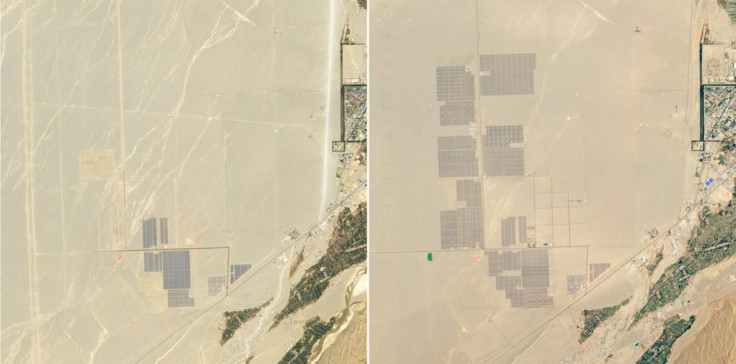NASA Satellite Images Show China Building A Massive Solar Power Plant In The Middle Of The Gobi Desert

Satellite images captured by NASA show that China has tripled the size of its solar power plant in the Gobi Desert since 2012. It's another indication that China, pushed by the United Nations, is looking to become a global leader when it comes to solar power after decades of notorious pollution problems. That, and the NASA pictures just look really cool.
NASA's Advanced Land Imager on the Earth Observing-1 satellite aimed its camera at the Gobi, the largest desert in Asia, between 2012 and 2015. The satellite's orbit coincided with an increased urgency on solar power from Beijing, which is trying to reduce its use of fossil fuels by 60 to 65 percent between 2005 and 2030. Climate change observers have maintained that China, the world's most populated country, is responsible for at least 25 percent of the planet's carbon dioxide (CO2) emissions.
Expanding solar-energy systems in the Gobi Desert, where sun and real estate are plentiful, could be essential to hitting that goal. The solar power station was first thought to be producing 5.2 gigawatts of energy between 2009 and 2014. But by 2014 it was producing 28.05 gigawatts and reportedly expanded by another five percent through the first quarter of 2015.
“China is largely motivated by its strong national interests to tackle persistent air pollution problems, limit climate impacts and expand its renewable energy job force,” Jennifer Morgan, director of the climate program at the World Resources Institute, told National Geographic, adding that meeting the goal is plausible if China continues on its current path.
NASA's Advanced Land Imager, better known as the ALI, has been remarkably productive for the federal space agency. It's capable of capturing images of Earth at 30 meters per pixel (roughly equivalent to a zoomed-out view of Google Maps), giving U.S. scientists an unvarnished view of almost anywhere on the planet.
© Copyright IBTimes 2024. All rights reserved.





















